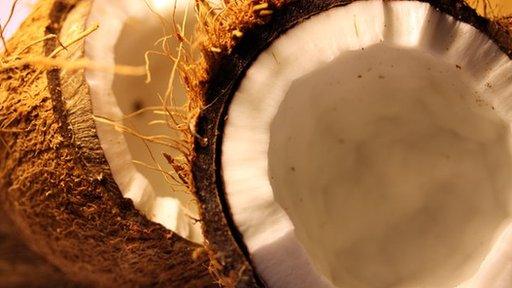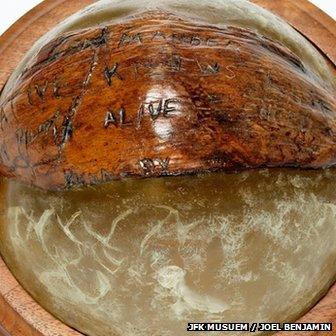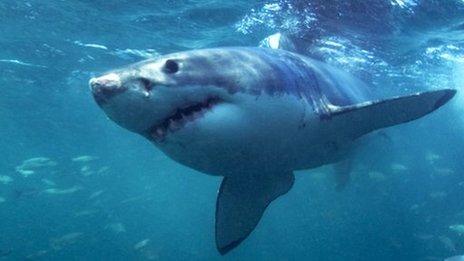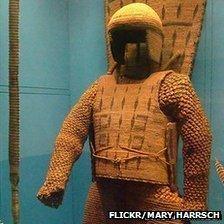Queen's Baton Relay: Four things you may not know about coconuts
- Published

Coconut oil is being used as a biofuel in the Solomon Islands as an alternative to traditional diesel which has to be imported into the country. In the capital, Honiara, John Vollrath makes coconut biofuel to power vehicles, and he now hopes its continued use as a fuel can provide employment in rural communities.
In a celebration of the humble food with powerful depths, here are four things you may not know about the coconut.
1. A coconut saved JFK

The coconut that saved a president
John F Kennedy, before becoming one of the most famous presidents in the history of the United States, had an important encounter with a particular coconut.
The then Lieutenant Kennedy was stranded on the Solomon Islands with his crew after their boat was attacked by the Japanese in 1943. The torpedo boat commander was found by some friendly islanders and he scratched a message on a coconut shell.
The shell with its message 'NAURO ISL … COMMANDER … NATIVE KNOWS POS'IT … HE CAN PILOT … 11 ALIVE … NEED SMALL BOAT … KENNEDY' was taken to the Allied commanders on another island by the locals, and the Americans were rescued.
The coconut message was preserved and made into a paperweight that sat on President Kennedy's desk in the Oval Office during his stay in the White House.
2. More deadly than sharks?
It has been widely claimed that coconuts kill more people every year than sharks. The London Sea Life Aquarium, external says 20 people meet their end at the hands of the ocean predator annually. This is compared with 150 unlucky souls who die after being hit by coconuts falling from trees. You may not believe this, and your scepticism is quite correct.

This Great White shark has dived below the waves to escape falling coconuts
The claim started its life in a 1984 journal article by Dr Peter Barss, who observed injuries caused by coconuts while working in a hospital in Papua New Guinea. The author's work was awarded the Ig Nobel prize - a comical science award for what commentators describe as research that "cannot or should not be replicated". However, as the Shark Research Institute of Australia, external reports, he never mentions the 150 figure. Nevertheless, public perception of the deadly coconut was fixed.
While there is no real evidence on how many people die from falling coconuts every year, you may want to avoid sleeping under a coconut tree.
3. Coconut bomb
The Evening Independent, a Florida newspaper, published a report, external in December 1944 about a Japanese attempt to use 'coconut bombs'. Describing a battle in the Philippines, an American colonel told how the coconuts were hollowed out by the Japanese forces and filled with grenades and acid. The coconuts were then sealed back up and thrown at the American soldiers. According to the colonel, the bomb made a "terrific explosion" but caused little damage.
4. Armoured food

A suit of coconut armour in the American Museum of Natural History
While the use of coconut fibres as a clothing material is not unheard of, it may surprise you to learn the coconut has also been used by Pacific islanders to make armour.
The Pitt Rivers collection of University of Oxford holds a suit from the island nation of Kiribati. The coconut fibres make up a cap, body armour, back plate, jerkin jacket and leggings, with the armour often accompanied by swords made with shark teeth.
A similar suit of armour is currently in storage at the Kelvingrove Art Gallery and Museum in Glasgow.
Mark Beaumont met John Vollrath and found out about his biofuel company as part of the journey of the Queen's Baton Relay around the Commonwealth.